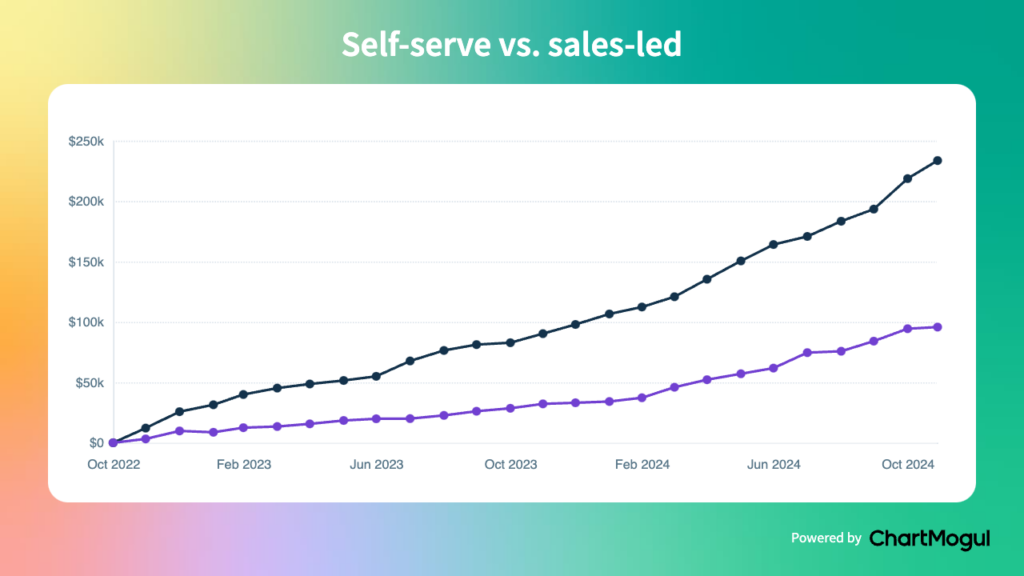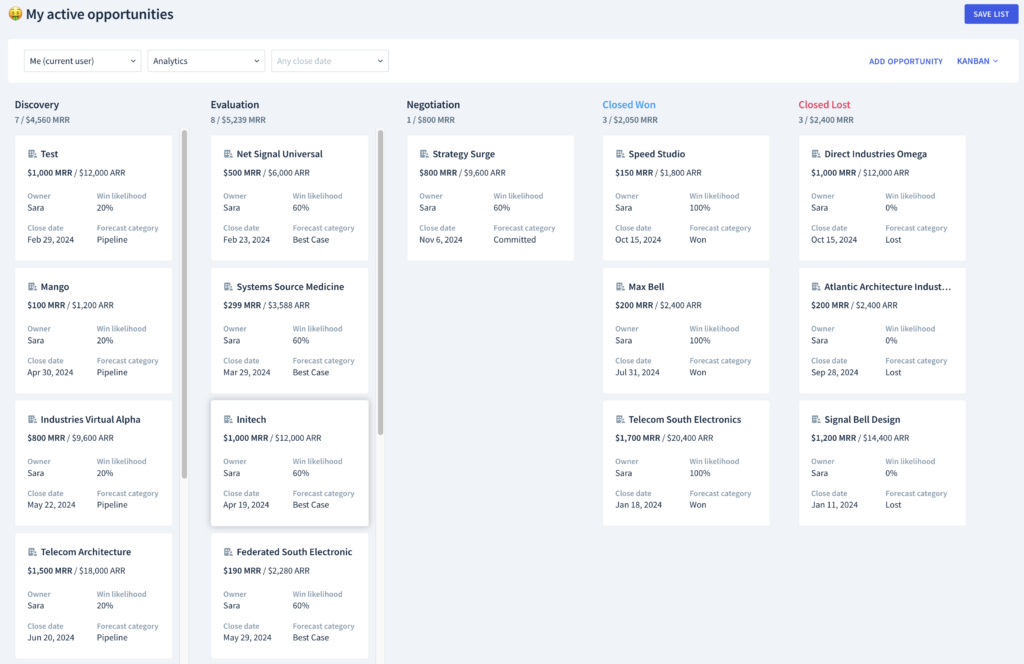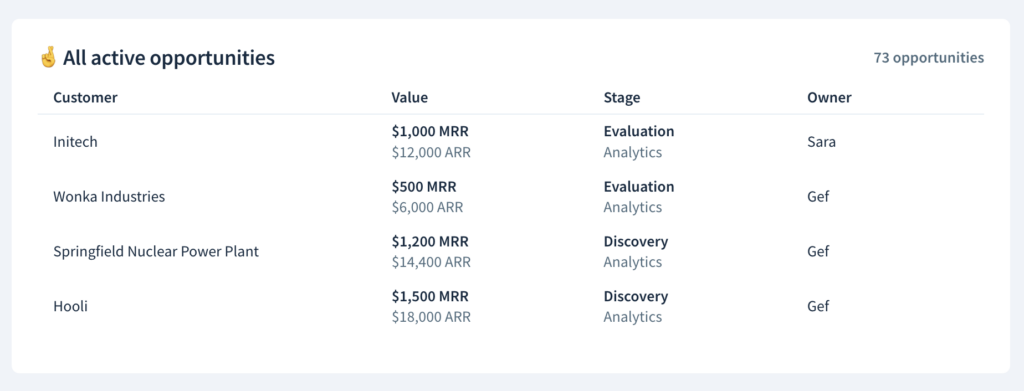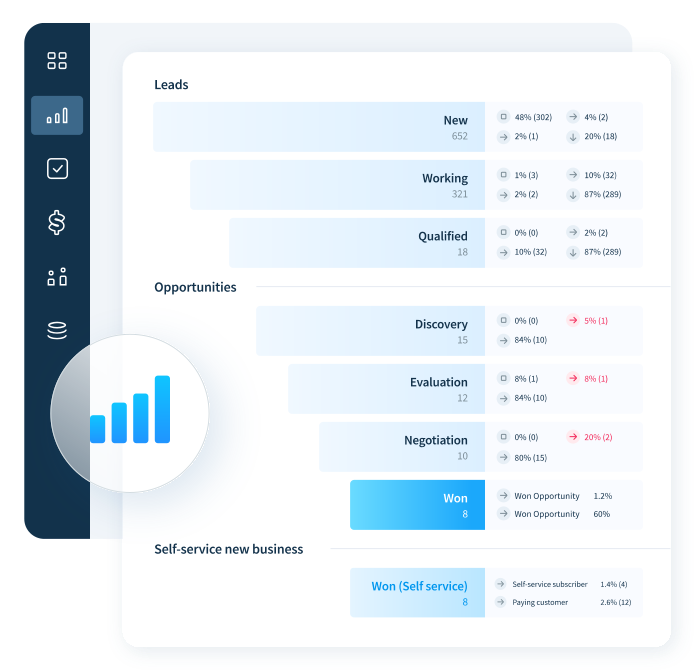You’ve built an amazing product—something you’re genuinely proud of. But now comes the part that can feel a little overwhelming: selling it. For many founders, it’s not just about convincing others—it’s stepping into a whole new role, figuring out what works, and hearing “no” more than you’d like. It’s challenging, no doubt, but it’s also where you start to see the product you worked so hard on in the hands of happy customers.
A few foundational steps—like choosing the right model, establishing a process, and setting clear targets—can help you set off on the right foot.
So read on, and hopefully, your SaaS sales journey will be less about trial and error and more about steady progress toward success.
- Understanding SaaS sales models
- Before you start selling
- A typical sales process
- Sales and revenue operations
- Setting sales targets
- Hiring salespeople
Understanding SaaS sales models
There are three main SaaS sales models, each tailored to different customer types and buying journeys.
Chances are, your strategy already incorporates at least one of these models. What’s important to note is that each model targets a distinct customer persona and, therefore, has a unique approach to the customer journey—from brand awareness to sales and, ultimately, conversion.
Here’s a breakdown of each:
1. Self-service sales model
This is when customers explore and experience your product independently without needing hands-on help from your sales team. Here, customers usually find your brand through marketing channels and then engage with it through tools like interactive self-guided demos, free trials, or freemium versions of your product.
Whether to offer a self-service model or not depends on a few factors: the product’s starting price, the level of customization involved, and how much support new users need to unlock its full potential.
🧲 PLG and self-service: same but different. Self-service sales often (but not always) go hand in hand with product-led growth (PLG)-driven motions. PLG-first SaaS companies rely on their product as the primary way to engage customers, making self-service sales a natural fit for conversion after experiencing the product. Nonetheless, it doesn’t prevent PLG-driven companies from incorporating other sales models for certain customer segments or needs.
Self-service works best for simpler, low-cost products where users don’t need much hand-holding, but it’s not limited to just those.
SaaS companies with more complex products often use the self-service model alongside other sales models to reach different types of customers. They’ll offer a simpler, entry-level version of their product for users who want to explore on their own while letting the sales team focus on customers who need a more hands-on approach—often the higher-value profiles.

2. High-touch sales models
With a high-touch model, sales reps guide prospective customers from initial interest to a purchase decision.
🧲 This sales model is typically adopted by organizations with a sales-led growth (SLG) strategy at their core. While it can be used on its own, it’s more common to create a hybrid approach that combines self-service and high-touch models to reach different audience segments effectively.
The high-touch model can be split into two types:
Transactional sales model
Unlike the enterprise model we’ll discuss next, this approach isn’t limited to high-ticket or complex custom solutions. It’s often blended with a self-service model, like when a website prompts users to sign up for free or book a demo first. The main goal here is to help hesitant prospects find the right plan for their needs—and, ideally, guide them toward a higher-tier plan if it really fits their needs best.
But it’s not uncommon to adopt the transactional sales model on its own, especially in innovative niches where customers aren’t just switching solutions but adopting entirely new workflows. In these cases, the model helps communicate the value of the change and introduces prospects to the innovation.
Enterprise sales model
The enterprise sales model is used for high-value, complex sales. This model typically requires a more hands-on, consultative approach, with sales reps working closely with potential customers over an extended period.
How is it different from transactional sales? The expected length of the sales cycle and the number of stakeholders involved are the main differentiators between the transactional and enterprise sales models.
Enterprise sales are often outbound or referral-driven. Most likely, there are fewer target accounts. Your sales team may need to map out all potential targets and how to access potential buyers within those larger businesses.
Larger ticket values may require navigating complex procurement processes to include security and compliance checks, therefore prolonging the SaaS sales cycle.
While there may still be options like ‘Book a Demo’ or ‘Contact Us for a Custom Quote’ on the website, this model typically involves proactively identifying and reaching out to potential customers.
💡 You can see how your self-service is performing compared to sales-led motions in ChartMogul CRM. Our Funnel Pipeline Analysis report visualizes your entire sales-led pipeline and provides a snapshot of your self-service sales performance at the bottom, giving you a clear comparison of both.

Before you start selling
Before you dive into selling, there’s some groundwork to lay. It’s not just about knowing who your customers are—it’s about having clear hypotheses that you can test on your journey to find product-market fit. Here are the basics you need to get started.
Ideal customer profile (ICP)
This involves identifying the key characteristics of the businesses or individuals your product is built for. It’s not just anyone who might sign up for your product and benefit from it, but a very specific category of potential buyers who are most likely to become high-value customers.
Buyer personas
Go beyond the ICP and identify the specific decision-makers and influencers within your target companies. Look out for those individuals that are excited about new categories of tech. The best champions will have the influence and/or authority to set strategy and make decisions.
Clear value proposition
Understand and articulate why your product is the best solution for your customers’ problems. What makes you stand out? Tailor your pitch and communication to address your customers’ pain points and priorities. This will change over time, but to start, you need something that will capture the attention and interest of your prospects.
The beginnings of a sales playbook
Develop a place where you can store fungible assets that help you throughout the sales process. This can include qualification questions, scripts, objection handling strategies, and email templates.
CRM and tools
Have the right tech stack to manage leads, track progress, and ensure no opportunities fall through the cracks.

Metrics and KPIs
Set clear goals like conversion rates, time-to-close, and average deal size to measure success and identify areas to improve.

A typical SaaS sales process
While it’s impossible to fit every sales process into a one-size-fits-all model, this should give you a general idea of what a transactional or enterprise-driven sales process typically looks like:
1. Prospecting
Outbound prospecting involves actively reaching out to potential customers through channels like direct emails, cold calls, or social media. The goal here is to source qualified leads by identifying and connecting with people and organizations that match your ICP.

A clear ICP should guide you in deciding where to search for those target accounts, what to look for in them, and how to start conversations with them.
💡 Customers might as well find you through your marketing efforts like paid ads or SEO; we’re not covering this step as it’s not a part of an outbound sales motion.
2. Discovery
Discovery is an ongoing process: it begins prior to initial outreach and continues immediately afterward. Before reaching out, your team assesses prospects to see if they align with your ideal customer profile (ICP) based on available data. After initial contact, sales reps validate these assumptions by gauging the prospect’s level of interest, needs, and fit.

What does “Qualified” really mean for your team?
Qualification standards can vary widely from one business to another, depending on factors like the industry, target market, and sales goals. For some, a “qualified” lead might be someone who fits the ICP and has shown basic interest, like downloading an ebook. For others, it might mean a decision-maker with a defined budget and a pressing need for your solution. That’s why it’s crucial to create a clear, consistent definition of what “qualified” means for your sales process. This not only helps your team focus their efforts on the right prospects but also ensures smoother handoffs between marketing and sales. By being precise about qualification criteria—such as company size, role, budget, or urgency—you’ll save time, improve conversions, and keep everyone aligned on what success looks like.
3. Evaluation
Discovery call
During a discovery call, it’s your job to understand what the customer is trying to accomplish and if you can reasonably help. Come prepared with a basic understanding of the business: where are they located, what lines of product or service do they offer, what is the person you’re talking with responsible for?
On the call, start by setting the agenda and building rapport to make the prospect comfortable.
Ask open-ended questions to uncover their challenges, goals, and decision-making process. Take notes, stay curious, and dig deeper into their pain points to understand how your solution can truly help. There’s no shortage of approaches to running a discovery or qualification all. From BANT to MEDDIC to SPICED, figuring out the right approach can be overwhelming.
At ChartMogul, we employ a simple customer-centric discovery methodology. We call it NTA-ab. NTA-ab is BANT workshopped and stands for:
- Need
- Timing
- Alternatives
- authority
- budget
The N,T, and A, are capitalized because that’s what your customer cares about. They want to know: can you help them solve core business challenges in an acceptable time frame? And if they don’t pursue your solution, what alternatives exist to get them to their desired outcome?

Only when you have developed a keen understanding of your customer’s needs can you earn the right to ask questions about their decision-making process.
If you employ NTA-ab or something else, it’s important that you avoid pitching your product too early. It’s not until you truly understand your customer’s vision (and even their customers’ vision) that you can fully demonstrate the power and value of what you built.
Crimes of Discovery
- Being a lazy listener
- Filling the silence
- Not being prepared for your call
- Not doing your homework
- Bad tech
- Offering a solution without listening
- Asking leading questions that map to your strengths and/or to demo
Product demo
After you have a basic understanding of what it is your customer is trying to accomplish, you are now in a position to showcase how your product offering addresses this underlying need. A demo should help your customer reimagine their reality. Here you present how their approach to work might change by implementing your solution.

Keep in mind: a sales demo is more than just a sales presentation; it’s also another step in the ongoing qualification process. Revisit the main topics discussed in initial conversations and reaffirm your understanding of how you can best help your buyer accomplish their business objectives. In longer sales cycles, a demo is typically followed by a long sequence of discussions, negotiations, and, oftentimes, meetings with the product team planning the development of customized solutions.
Before going all in on that opportunity, the sales team should evaluate whether the prospect truly aligns with the ICP and has the potential to convert, or if pursuing them further would result in a productive relationship for both parties.
4. Closing
At this stage, the goal is to finalize the deal and get the prospect to commit. Closing involves addressing any last-minute objections, negotiating terms, and securing signatures. The goal of this stage is to get to a decision in a way that makes the client feel ‘whole’ without sacrificing key business. Sales reps might lean on tailored offers or customized contract terms to lock in high-value customers.
5. Onboarding
Once the contract is signed, it’s time to get the new customer up and running. Onboarding is all about setting customers up for success with your product, and it can look different depending on the complexity of the solution.
For straightforward SaaS products, onboarding might mean giving users access to tutorials, walkthroughs, and support resources. For enterprise solutions, the process is typically more hands-on, involving training sessions, dedicated support, and regular check-ins.

Managing the customer onboarding process within ChartMogul CRM.
An effective onboarding process can significantly impact customer retention, as it’s the first real experience the customer has with your product beyond the demo. A smooth onboarding phase builds trust and confidence and sets the customer on the path to long-term value.
Where do sales and revenue operations fit in all this?
It’s the classic question for growing startups: when is the right time to bring sales and revenue operations (RevOps) into your sales process—and should you?
A general advice is to bring in Ops before starting to scale sales efforts in a major way. This way, you start with the right systems and workflows from scratch, instead of having to firefight later on.
“If you’re thinking ‘Hey, I probably need an Ops person,’ then it’s probably too late.”
Dani Riggs, Head of Revenue & Business Operations, Accord
But in reality, many successful startups don’t follow this path. Too often, fast-growing teams build their processes on the fly to meet budget and timeline constraints, giving everyone the freedom to create their own setups. It works—until it doesn’t. As they scale and run into issues with those initial setups, they bring in Ops to clean up and streamline.
“It makes sense to say ‘run as fast as you can, for as long as you can,’ and when the Ops person comes in, they’re going to have to undo some of the tech dept that’s happening.
But the cost of that tech dept with no-code isn’t actually as much as it used to be. As we get more integrations-focused, I like to wait a little longer for sales operations and rely on people’s autonomy of creating what they need for their role—as long as someone is keeping an eye on all of it.
Pretty soon, more and more people will start more and more similar issues, and that’s a sign to you that you need an Ops person that’s going to solve a lot of these problems…”
Graham Hunter, former Head of Segment’s Startups Program
Setting SaaS sales targets
Hitting sales quotas is one thing; setting realistic, aligned quotas to actually drive your revenue goals is a whole different challenge. Setting targets is a bit of art and science. You want to set ambitious but attainable goals that push the boundary of what’s possible without setting yourself or your team up for failure. For SaaS sales, where long-term value heavily relies on retaining those first-time customers, setting sales targets goes beyond simply aiming for high numbers.
What’s that about?
In SaaS, your goals can’t just be about filling the pipeline with anyone willing to sign up. Setting quotas too high can lead to a flurry of new customers who aren’t well-qualified, driving up acquisition costs without much payoff in terms of long-term retention.
Your sales targets should factor in both acquisition and retention. In your calculations, consider not only how many new customers you need to reach revenue goals but also how many of those customers are likely to stay on board and ideally expand their subscription.
In the beginning, it will be challenging to set revenue targets—largely because you have little to no data. For this reason, it can be prudent to set a customer count or logo target.
A basic sales target might look like this: close 10 customers in Q4.
The majority of SaaS startups grow from $1M to $10M ARR by growing their subscriber base. For any startup, there are only two components to growth — subscriber growth and ARPA growth. Most startups grow by increasing their subscriber base. A small subset (<5%) of startups grow predominantly by increasing their ARPA. What this tells us is that in the early days, it’s best to focus speed when it comes to logo acquisition.

Over time, you can shift to setting revenue targets by looking at how much new business MRR you can expect in any time interval. To ensure that your team is onboarding right-fit customers, consider rewarding them credit for an account that expands within the first three months of purchase. On the flip side, consider docking reps when they onboard a customer who contracts or churns shortly after becoming a paid subscriber. Limiting this to just three months keeps the focus on hunting for new business.
💡 How to align sales and revenue tracking
To make sure your sales team isn’t just meeting quotas but also contributing to overall revenue growth, you need to align their goals with company-wide financial targets.
But how do you do that? ChartMogul combines lead, trial, opportunity, and subscription data together in a single system. ChartMogul CRM gives your sales team a clear overview of their pipeline and helps you track progress toward sales targets. At the same time, ChartMogul Subscription Analytics can break down metrics like monthly recurring revenue (MRR) and customer lifetime value (LTV), showing how each customer or cohort performs post-sale.

All things considered, here are a few examples of SaaS sales metrics to watch:
- Leads
- Average Deal Size
- Sales Cycle Length
- Average Sale Price
- Win Rate by Source (tip: you can also compare the rest of the metrics by source to gauge the effectiveness of your sales-led motions versus self-service sales)
- Customer Acquisition Cost (CAC)
- Customer Lifetime Value (CLV)
- Monthly Recurring Revenue (MRR)
- Churn Rate
Once you’ve selected your sales KPIs, you can set them as targets directly from your ChartMogul dashboard. From there, you’ll be able to easily track your progress toward those targets by clicking the “Target” button.

Hiring sales people
Hiring your first salesperson at a startup is a big step—you’ll ask this person for a lot. They’ll need to represent your product, be the voice of your customer, and juggle sales targets without a lot of well-defined sales resources. That means your first two sales hires should be credible go-getters that are comfortable working towards ambitious goals while operating in an environment of uncertainty.
When you’re no longer able to manage sales yourself, it is ideal to hire two salespeople. The logic here is that (1) if you hire one you’ll be unsure of what constitutes good and (2) you’ll have some redundancy if a hire doesn’t work out.
For most SaaS companies, it is prudent to hire salespeople who have worked similar deal sizes and sales cycle lengths.
Following a structured recruitment process, will help you make an objective decision and avoid the feeling of ‘being sold to’ during an interview. Begin by evaluating what you need in a sales rep. Define the core skills and knowledge that will ensure success.
Here is a sample list of characteristics we evaluate during our AE hiring process:
- Business acumen
- Consistent execution
- Storytelling
- Likeability
- Offers a unique perspective
- Drives two-way communication
- Credible as an expert in SaaS
- Comfortable discussing money
- Can pressure the customer
It’s possible that you find a candidate that you’re ready to hire, but who does not excel at every targeted competency. With a structured interviewing process like this, you can identify areas of potential concern and proactively work them into your onboarding and management strategy.
Be upfront about what the role has to offer and try to clearly articulate what constitutes success. Sales is a profit center and needs to be producing relatively consistent results from one quarter to the next.
On scaling the team
At some point, you will no longer have the knowledge, skills, or time required to coach your initial sales team. And so you’ll likely hire a sales manager. This person should have a clear understanding of your go-to-market motion and your ambitions for the business. Their primary responsibilities are to the leadership team and the business—not to their reps.
They should be focused on setting up the right infrastructure and playbooks to hit ARR growth targets in a sustainable way.
What makes a great SaaS salesperson
SaaS businesses have a different approach to sales, depending on its maturity.
Founder-led sales
Founder-led sales in SaaS startups can be both exciting and challenging. As a founder, you’re likely passionate about your product and know it inside out, which makes you the perfect person to sell it early on. But it’s tough because selling isn’t just about explaining features—it’s about understanding the customer’s needs, handling objections, and navigating rejection, all while juggling a hundred other priorities.
It’s hard to stay consistent with sales when you’re also focused on fundraising, building the product, and growing the team. Plus, founders often lack formal sales training, which means learning on the job, making mistakes, and refining the pitch as they go. It’s a rewarding but intense phase that helps shape the company’s early growth.
Hiring your first salesperson
Hiring your first salesperson at a startup is a big step—it’s like passing the torch on something deeply personal. This person will be the voice of your product, so finding someone who aligns with your vision is key. But it’s tricky because you’re often hiring before you’ve nailed a repeatable sales process. You need someone scrappy, adaptable, and willing to experiment, not just someone who thrives in established playbooks. Cultural fit matters too—they should share your passion for the mission and be ready to wear many hats.
Most importantly, this hire isn’t just about closing deals; they’ll help you shape the foundation of your sales strategy, so choose someone who’s as excited about building as they are about selling.
Growing a sales team
Growing SaaS sales teams at a startup is all about finding balance—scaling fast enough to meet demand but not so fast that you lose focus. Early on, you need a mix of builders and closers: people who can sell but also help refine your processes and tools. It’s a challenge because every new hire changes the team dynamic, and culture can evolve quickly if you’re not intentional about preserving it. Training is key too; you’re likely still tweaking your pitch and value propositions, so you need to make sure everyone’s aligned.
As the team grows, it’s also crucial to establish clear roles, goals, and accountability. The ultimate goal is to create a repeatable, scalable sales engine—but in the meantime, it’s a lot of experimentation, feedback loops, and learning as you go.
Sales management
Sales management is categorically different from managing other disciplines within the business. This is in large part because as much as 100% (but more typically 40-50%) of sales team compensation is based on performance. Sales is a volatile high-performance sport and requires quite a bit of mental fortitude.
Managing salespeople requires a balance of empathy and steeliness. So what should you keep in mind when managing a sales team?
- Creating a sense of purpose and alignment with company goals.
- Non-monetary incentives (e.g., recognition, career growth opportunities).
- Avoiding burnout in high-pressure sales environments.
Encouraging teamwork while maintaining healthy competition.
FAQ: SaaS Sales in Startups
What is a typical SaaS sales process for startups?
A SaaS sales process usually involves identifying target customers, qualifying leads, conducting product demos, handling objections, and closing deals. Startups often iterate on this process as they learn more about their market and customers, so flexibility and experimentation are key early on.
When should a SaaS startup hire its first sales rep?
You should consider hiring your first sales rep when you’ve validated your product-market fit and have a rough idea of your ideal customer profile and sales process. A good sales rep at this stage should be adaptable, able to refine your sales approach, and comfortable working with minimal structure. Your SaaS sales reps need to prioritize tasks, follow up with leads, and keep track of their progress through the sales funnel.
